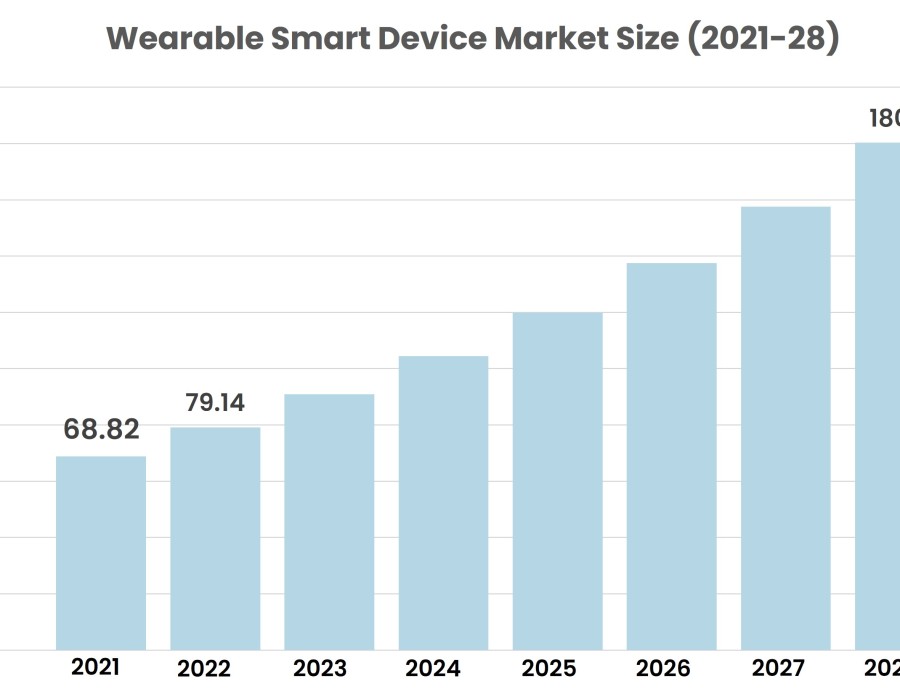The future of wearable smart devices promises to redefine how we interact with technology on a personal level, integrating seamlessly into our daily lives while advancing capabilities across various sectors. Here's a look at some key innovations and trends shaping this exciting field:
According to Stratview Research, the wearable smart device market was estimated at USD 68.82 billion in 2021 and is likely to grow at a CAGR of 14.7% during 2022-2028 to reach USD 180.3 billion in 2028.
Innovations Driving the Future of Wearable Smart Devices
1. Health Monitoring Beyond Basics
Wearable devices are moving beyond simple step counts and heart rate monitoring. Future innovations include more advanced health sensors capable of monitoring blood glucose levels, hydration status, and even biomarkers indicative of early signs of diseases like cancer or infections. These advancements will enable earlier detection and more proactive management of health conditions.
2. Integration with AI and Machine Learning
Artificial Intelligence (AI) and machine learning algorithms are becoming increasingly integral to wearable devices. They can analyze vast amounts of data collected by wearables to provide personalized insights and predictive analytics. This integration will enhance device functionality, from optimizing fitness routines to predicting health risks based on lifestyle patterns.
3. Enhanced Connectivity and 5G Integration
The rollout of 5G technology will revolutionize wearable devices by enabling faster data transmission and lower latency. This means wearables will be able to seamlessly connect with other devices and cloud services in real-time, enhancing their capability to deliver instant feedback and support for users.
4. Augmented Reality (AR) and Virtual Reality (VR) Integration
Wearables are poised to merge with AR and VR technologies, offering immersive experiences for users in various fields such as gaming, education, and training. Devices like smart glasses could provide real-time information overlays, enhancing situational awareness or aiding in complex tasks.
5. Flexible and Biocompatible Materials
Advancements in materials science are paving the way for flexible, lightweight, and biocompatible wearables. These materials are not only comfortable to wear but also allow for more innovative form factors, such as wearables integrated into clothing or even directly onto the skin.
6. Focus on Mental Health and Well-being
Future wearables will increasingly prioritize mental health monitoring and support. They may incorporate features like stress detection, mood tracking, and personalized mindfulness exercises to promote emotional well-being and resilience.
Trends Shaping the Adoption of Wearable Smart Devices
1. Consumer Adoption and Market Growth
The wearable device market continues to expand rapidly, driven by consumer demand for health and fitness tracking, convenience, and connectivity. As devices become more affordable and feature-rich, adoption rates are expected to rise across demographics.
2. Regulatory and Privacy Concerns
As wearable devices collect more personal health data, regulatory bodies are paying closer attention to privacy and data security issues. Future trends will likely include stricter regulations governing data collection, storage, and usage to protect user privacy.
3. Ecosystem Integration and Interoperability
Integration with broader ecosystems, including healthcare providers, fitness apps, and smart home devices, will enhance the utility of wearables. Interoperability standards will become crucial to ensure seamless data sharing and integration across platforms.
Conclusion
The future of wearable smart devices holds immense promise, driven by innovations in health monitoring, AI integration, connectivity, and material science. As these technologies continue to evolve, wearables will play a pivotal role in promoting personalized healthcare, enhancing daily productivity, and enriching user experiences across diverse applications. Embracing these trends will not only shape the future of wearable technology but also empower individuals to lead healthier, more connected lives.






Comments